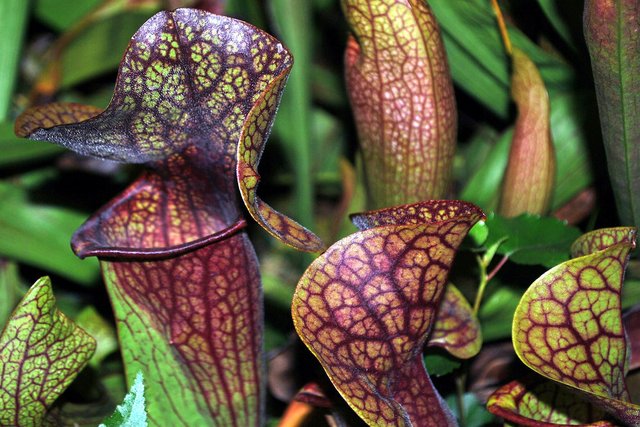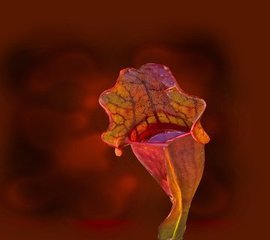The carnivorous plant encyclopedia - Chapter 2: plants for the advanced: Sarracenia (Trumpet pitcher) - the duplicitous allurer
Sarracenia (Trumpet pitcher):
Habitat:
Sarracenias are very popular among carnivorous plant enthusiasts because of their size (up to one meter in height) and their hardiness. There are eight Sarracenia species in nature, of which seven are endemic to the North American coastal plain of the United States. One species, the Sarracenia purpurea even inhabits artic regions. Thanks to Sarracenias' hardiness, it is therefore not surprising that this species is being artificially cultivated in many places around the world such as Germany, Ireland or Switzerland, which is a good thing because over decades many species have been severely decimated in their natural habitat due to drainage.
 Source |  Source |
Cultivation:
Albeit possible, Sarracenias don't acclimate easily to the indoor terrarium because they need plenty of humidity and sun. Growing them in an outdoor mini swamp biotope is most convenient for their successful development, specifically because here this plant’s preference for rather cool temperatures in the root area can be met best. Especially the Sarracenia purpurea is very often part of garden centers' carnivorous plant assortments. Most species overwinter effortlessly. The subspecies Sarracenia purpurea ssp. purpurea is particularly hardy, being able to withstand frosts of minus 30°C. If a plant decays during winter the culprit usually is aridity. Before Sarracenias produce their typical pitchers they go through a flowering period in early spring (right image below), whereby wonderful blossoms cover the plant's mouth so as to ensure that pollination by insects can go down smoothly. Cultivating Sarracenias requires patience; it can take up to three years for the Sarracenia to unleash its full growth potential. When considering buying one in a garden center, don't get hung up about potential color desaturation or damage: most important is a healthy rhizome, so that under the right conditions new pitchers can thrive.
 Source |  Source |
Trap mechanism:

Sarracenias have a passive pitfall trap mechanism that lures many insects by means of gaudy colorplay, alluring scent and extrafloral nectaries produced on the lip (=peristome) of the pitcher leaves. Here, slippery footing makes insects fall into the tube, where the digestive process takes place. Most species don't have a lot of digestive juices inside the pitcher, therefore their leaf lid (=operculum) has a stronger bend to prevent rainwater from diluting the precious fluid. Sarracenia purpurea is the only species that has no real bending of the lid and instead welcomes rainwater influx, because it gives off its digestive enzyme to the rainwater that it collects inside the pitcher, whereby the digestion itself occurs by means of bacteria and microbes. During midsummer the pitchers of Sarracenias growing outdoors are normally brimming with insects, entailing not only the decaying of the insects' chitinous exoskeletons but also of the pitcher itself. That's absolutely fine, however, because this is exactly the purpose of the pitcher. New pitchers will then grow even quicker and more splendid.
Much Love and Light,
Alex
Literature inspiration: Kosmos Garten: Fleischfressende Pflanzen

Nice colors
Thank you so much for participating in the Partiko Delegation Plan Round 1! We really appreciate your support! As part of the delegation benefits, we just gave you a 3.00% upvote! Together, let’s change the world!